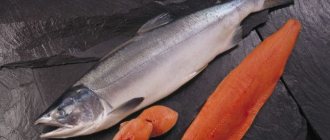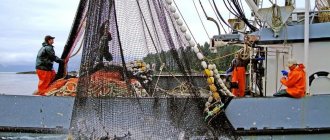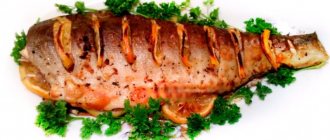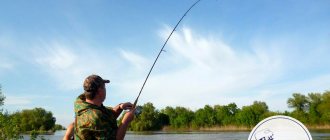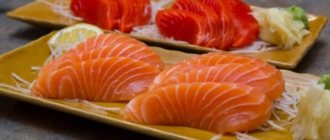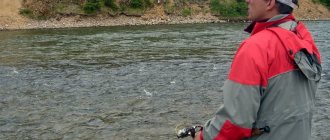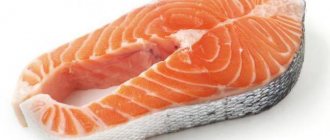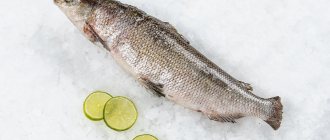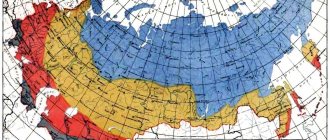When do pink salmon go to spawn?
The process of spawning in pink salmon is quite complex. Before giving birth to offspring, fish are forced to travel vast distances. The fish's permanent place of residence is the sea, and pink salmon have to look for a fresh body of water to spawn. By the way, the fish often returns to the place where it once spawned.
Pink salmon are found along the American coast, in rivers from the south to Alaska. In our country, pink salmon can be found from the Lena River to Peter the Great Bay, on Sakhalin, the Commander and Kuril Islands. Pink salmon is a migratory fish. First, she will have plenty of fun in the northern waters of the Pacific Ocean, swimming to the Okhotsk Sea of Japan and the Bering Sea. During this period of life, pink salmon do not form schools and stay in the upper layers - no more than 10 m. The diet includes small fish and crustaceans. Pink salmon spend the winter near Kuroshio.
With the approach of spring, pink salmon changes course to the north, dividing into two parts: the young, having finally fattened up in the northern waters, turn back to the south, and the fish that have reached sexual maturity rush to their spawning grounds.
Pink salmon begin spawning in late spring and finish in early autumn. Pink salmon, like chum salmon, prefer to produce offspring when the water temperature reaches 12-16 degrees.
Description
“/>The body is slender, covered with small scales. The sides and belly are silvery in color, the back is dark. The lateral line is clearly visible. There are large and small dark spots on the caudal fin, and small ones on the back. After entering rivers and staying in fresh water, pink salmon acquires their nuptial plumage: the body flattens and becomes brown in color, the head and fins turn black, the jaws bend, and large teeth grow on them. Males develop a hump on their back.
The smallest representative of salmon. The maximum length does not exceed 68 cm, and the weight is 3.0 kg. Males are usually larger than females. Pink salmon all mature in the second year of life. Spawning along the main channel and along the lower reaches of large tributaries. Spawning grounds are located on rifts with clean water and on non-silted soil consisting of gravel and pebbles mixed with sand. Spawning occurs in August and continues until mid-September. Caviar with a diameter of 6 mm. At the end of April, the larvae emerge into the water column and slide down the river. After going to sea, the juveniles stay in shallow waters for about a month, actively feeding on small crustaceans. After a year and a half of marine life, pink salmon return to their native rivers to spawn. Homing (the instinct of the native river) is less pronounced in pink salmon than in other Pacific salmon.
Pink salmon is the most numerous representative of the Pacific salmon genus. It lives in the northern part of the Pacific Ocean, is found in the Arctic Ocean west to Lena and along the Asian coast south to the Korean Peninsula and the shores of Hokkaido and Honshu. Along the American coast, pink salmon are also widely distributed - from the Colville River in the Arctic Ocean to the San Lorenzo River in California. It is most numerous in the northern part of the Sea of Japan, the Sea of Okhotsk, the South Kuril Islands, eastern Kamchatka, the southeastern part of the Gulf of Alaska and British Columbia.
According to literature data, it reaches a maximum length of 76 cm and a weight of 5.7 kg. Usually, pink salmon ranging from 32 to 64 cm in length go to rivers to spawn, with a predominance of individuals 38-59 cm in length and weighing 1.4 - 2.3 kg. As a rule, in years of high abundance, fish sizes are 2.5–5.7 cm smaller than in low-abundance generations. The exception is the pink salmon of northern Primorye and British Columbia, where the opposite trend is observed. Males, like other Far Eastern salmon, are larger than females. Pink salmon live for 1.5 years, in the second year almost all of them become sexually mature. Therefore, generations of even and odd years are genetically isolated almost completely.
Pink salmon as a species is homogeneous and it is impossible to distinguish subspecies. The high stability of species characteristics of pink salmon can be explained by the following reasons: the absence of pronounced homing and, as a consequence, the possibility of crossing even significantly distant populations; extremely short period of stay in fresh waters and living for most of life in very homogeneous ocean conditions; historical youth of the species; a wide range of resistance to external environmental factors during the breeding season and early feeding at sea.
Favorite spawning places for pink salmon?
During the summer, the fish strives to get to the spawning ground, the place where it once spawned. Today it is difficult to say how pink salmon recognize their river, how they find their way to the source. Experiments led to the conclusion that the female detects her birthplace by the bottom smell.
When the path is set, the pink salmon will not be stopped by either the current, riffles, or bottom holes with rapids and waterfalls. During this period, the fish does not eat, changing greatly in appearance.

Like most Pacific salmon, pink salmon bury their fertilized eggs in the ground. Spawning occurs in river channels with strong currents. It is better if the bottom is pebbly. The spawning site is located lower downstream than that of other salmon.
During the spawning period, pink salmon are accompanied by males. The female, on the other hand, looks upstream and with powerful movements of her tail breaks the bottom, where large eggs of a light yellow hue (at least 5 mm in diameter) will subsequently fall. The male, being in constant struggle with rivals, generously pours milk on the eggs. Pink salmon can lay up to 1,500 eggs at a time. Having finished the eggs, the hole is filled with pebbles until a tubercle is formed, in which future fry will develop for almost 4 months.
Commercial value
Pink salmon meat has very good taste characteristics and is perfect for a variety of cooking methods. The valuable caviar of this fish is the largest among fish that belong to the genus Oncorhynchus.
Pink salmon is the most important commercial fish, occupying a leading position in terms of catch size among salmon, and in Kamchatka its regular catch is 80%. The main areas for pink salmon production are still the western territory of Kamchatka and the lower reaches of the Amur. The extraction of valuable commercial fish is carried out using fixed, cast seines and floating nets. Catch indicators over the years have characteristic periodic fluctuations.
Return to content
Salmon fish spawning
Caviar is considered a valuable and quite expensive product. The cost is determined by many factors, the main one of which is the reduction of individuals due to the high mortality of fish during spawning and poaching.
Spawning season and salmon mortality
The process of salmon reproduction is quite complex. Before the “offspring” appears, the fish needs to cover a significant distance - salmon live in the sea, and spawning occurs in fresh water, and, as a rule, individuals return to spawn exactly where they were born.
Spawning in salmon lasts from late spring to early autumn, since fish species spawn at different times. Sockeye salmon is one of the first to begin spawning (May), followed by chum salmon and pink salmon in early June, then chinook salmon and other salmon. As a rule, fish are guided by water temperature. For example, water at 5-8 degrees is quite comfortable for sockeye salmon; pink salmon and chum salmon prefer warmer conditions to begin reproduction - water at 12-16 degrees.
There is a myth that salmon spawn once in their lives and then die. This is not entirely true, each individual can give birth to offspring up to 4 times, but this happens quite rarely. As a rule, spawning occurs 2-3 times and the fish dies. The highest mortality rate after spawning is found in northern and Baltic salmon, but Atlantic salmon are more hardy.
How does spawning occur?
Typically, salmon are ready to reproduce by 3 years of age. In late spring or summer (depending on the species), they gather in flocks and move from the sea to fresh water bodies. In an effort to spawn, salmon develop enormous speed - up to 65 km/h, and on its way the fish can overcome serious obstacles, the height of which reaches 2-3 meters, this happens thanks to the well-developed tail section.
During spawning, salmon seriously change their appearance - instead of a pleasant silver color, red and black spots appear; nature, protecting the individuals, makes them look like poisonous ones, so that no one can make an attempt on their life (which does not stop poachers). In some species of salmon, a hump (pink salmon) appears, the teeth become large, and the size and shape of the internal organs also change.
In fresh water, fish stop feeding, previously accumulated fats become the only source of sustenance (hence exhaustion and high mortality of individuals). The amount of caviar increases quickly and leaves no room for food.
Salmon spawn at shallow depths, having previously cleared the bottom of debris and prepared a hole. There may be several depressions; after spawning, the fish fills them with sand. Salmon eggs are quite large, their number does not exceed 20 thousand. The older the individual, the more eggs it produces.
The spawning process - from the moment the eggs are formed to their “birth” - takes about 3 months. Maturation takes a long time, but the spawning process is quite short.
When does pink salmon go to spawn?
Prohibitions during pink salmon spawning
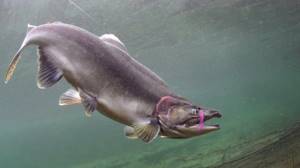
The law in each region is written differently. In the Sakhalin region, amateur fishermen will be offered several options. For those who wish to stock pink salmon, net fishing will be allowed in certain areas. Such fishing will be paid: what you pay is what you catch. A few years ago, a fishing map was developed that would help identify prohibited areas.
First of all, fishing is limited in protected areas, near bridges, locks, and dams. To fish on private property, you must obtain the owner's permission.
Amateurs can use spinning rods and fishing rods with a limited number of hooks for fishing. The network can be used in the Far East, Siberia and northern Russia. However, it is worth obtaining a license from the relevant authorities and assigning an individual number to the network.
Population and species status
In their natural habitat, periodic significant fluctuations in the number of pink salmon are observed. Most often this happens due to the special cyclical nature of their life; natural enemies do not have a significant impact on the population of this salmon species.
There is no risk of extinction of pink salmon, even though it is the most important fishery target. The status of the species is stable.
In the North Pacific Ocean, the pink salmon population (during its peak years, depending on the cyclicity of reproduction) has doubled compared to the seventies of the last century. This was influenced not only by natural growth, but also by the release of fry from incubators.
At the moment, there are no farms with a full cycle of pink salmon cultivation, which makes it even more valuable for the end consumer.
Pink salmon is not just nutritious and tasty, as many ordinary people perceive this fish when they meet it on the shelves of fish stores; in addition, pink salmon is an incredibly interesting creature with its own special way of life and behavioral instincts, the main purpose of which is to follow the call of procreation, overcoming all obstacles.
Pink salmon is a fast-growing species that matures in the 2nd year of life. The coastal pink salmon stock spends its marine life period in the southern and southwestern parts of the Sea of Japan (between 38-39° N.
sh.) in waters with temperatures from 8 to 11 ° C. Here it intensively feeds on large planktonic crustaceans, squid, anchovies, and then in the spring, in April, begins its spawning migration to the north.
By the end of May, pink salmon reach the latitude of Northern Primorye, and in June they migrate to coastal waters to the pre-estuarine spaces of spawning rivers.
Passage view. The rivers of Primorye enter all along the coast from the hall.
Peter the Great to the northernmost regions, where they are more numerous. The range in the North Pacific Ocean is as wide as that of chum salmon - from the shores of Korea on the Asian coast to California on the American coast.
In the Polar Basin it is distributed up to the river. Lena in the west and the river.
This is interesting: How to hunt sable with traps and husky
Mackenzie in the east.
The most numerous representative of Pacific salmon, occupying first place among this group of fish in terms of catch volume. The Primorsky pink salmon stock, unlike the Sakhalin and Kamchatka stocks, is relatively small and, as in other areas, is subject to significant interannual fluctuations.
Catch of pink salmon in Primorye during periods of high abundance in the 30s and 60s. was 8-10 thousand.
t, during low periods - up to 2.0 thousand tons.
Currently, its catches within the Primorsky Territory are small and range from 20 to 207 tons. They are caught with cast and fixed seines at approaches to spawning rivers and in rivers.
It is used mainly in salted and fresh-frozen forms, for the production of high-quality natural canned food and for caviar production.
A distinctive feature of the site about animals Zverey.Ru is the appearance of articles about a wide variety of fish. Today we will talk about commercial fish, which many people love for its taste. This is pink salmon. You will learn more about what pink salmon looks like, its description, characteristics of weight, length and life span, as well as spawning time.
We will also tell you how a male pink salmon differs from a female
, what type of fish it belongs to and who, besides humans, really likes to eat pink salmon and in which rivers of Russia it is found.
When does pink salmon begin to bite after spawning?
After spawning, most of the pink salmon die. The weakest ones die in the spawning area. Far Eastern reservoirs are covered with dead fish, which are called snenka. Crows and seagulls flock to the carrion.
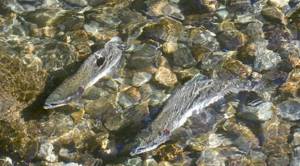
Post-spawning autumn catch is usually periodic. It has been noticed that in odd-numbered years, pink salmon are caught successfully in the Primorsky rivers, but in even-numbered years, fishing is not happy.
Pink salmon, like many other fish, have post-spawning apathy. After active spawning, the fish is weakened and does not eat much, although it is in great need of nutrition. In fact, the fish munch is present, however, due to the weakness of the fish, the fish bite takes place in an unusual mode for us. Pink salmon will not try to change their location with the goal of finding food. It will remain in one place until the current brings the bait “on a silver platter”.
What does shabby mean?
There is a term called "hound" which is described as a fish that has undergone spawning changes before or after spawning. The meat becomes like a slippery mass of an unattractive brownish tint, and tastes worse than usual.
In stores you can find products made from pink salmon, the packaging of which is marked “fish with spawning changes.” This means that in an individual that has gained strength and weight on the way to the spawning site, after laying eggs, reverse processes are launched. She stops eating, her immune defense is completely switched off, her body does not receive proteins and other useful substances. The fish is still alive, but most vital processes are suspended, and life in nature enters its final stage. An individual that spawns only once acquires an unattractive appearance: the skeleton, jaws, and scales change, which can be seen in photographs on the Internet.
Enterprising fishermen easily catch barely fluttering bodies in large containers and transport the carcasses en masse for further cutting and packaging. If the packaging contains an insignia that it contains products with spawning changes, and the abbreviation “C20” is stamped on the tin can, then this is a thin fish that is better not to eat. The taste of dishes of this type leaves much to be desired. No matter how much this product is baked in various spices, it will not bring any benefit to the human body and will not bring much pleasure.
